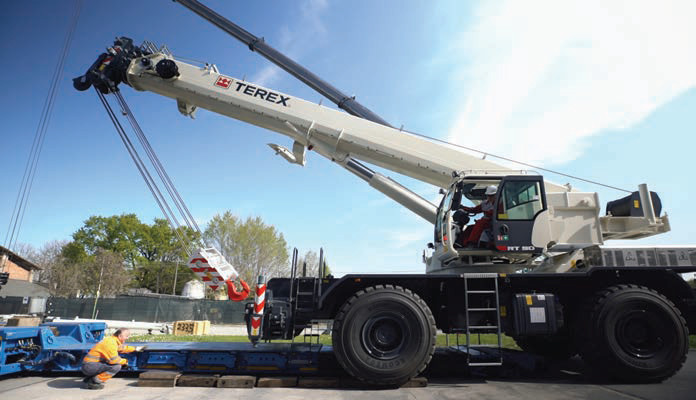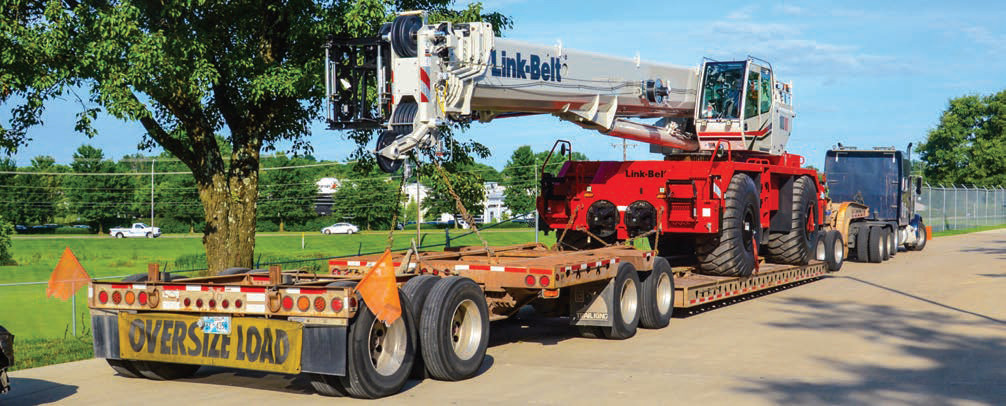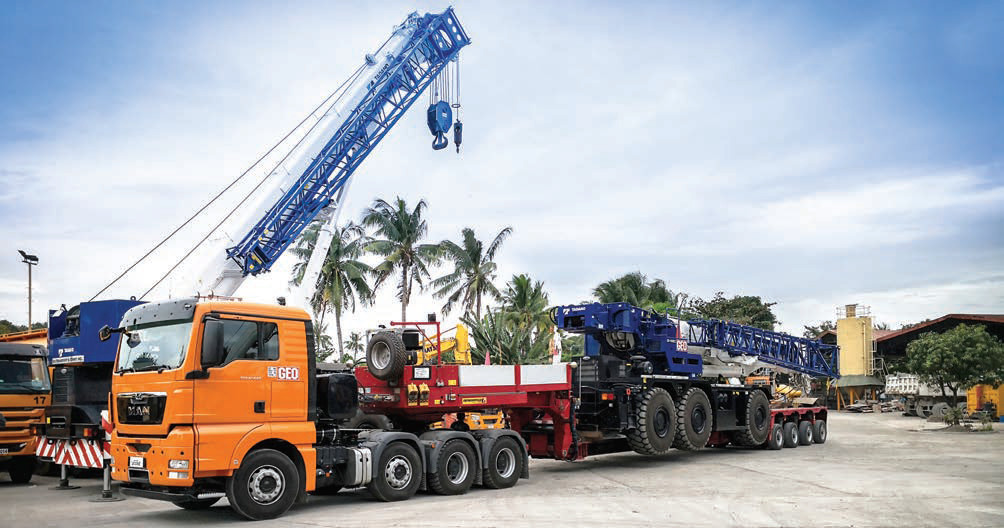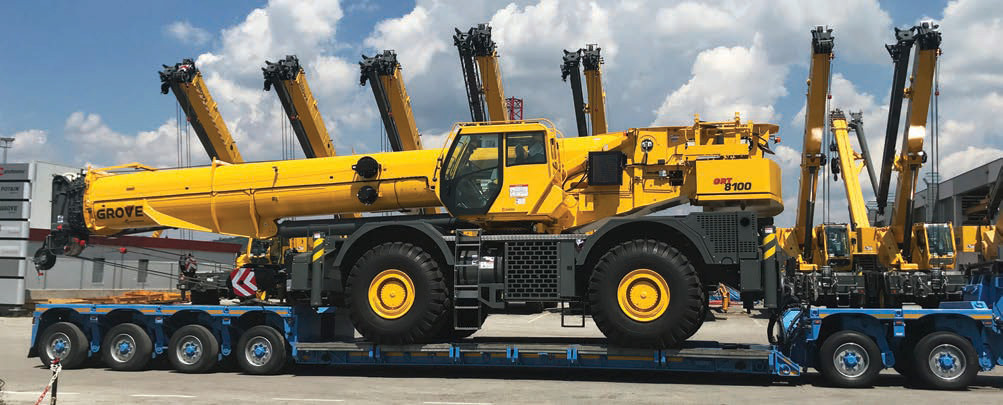From rough to level ground
8 August 2019Transporting large rough terrain cranes can be challenging, but manufacturers designed their cranes in a way to aid their customers. Sotiris Kanaris reports.
The applications that rough terrain cranes are used for often require their transportation over long distances. Especially for bigger machines, heavy haulage companies and crane rental companies around the world have to consider local regulations when it comes to how the crane will be transported.
In the US transportation within the country can be a real challenge, because the permits and regulations on heavy haul, oversize or overweight loads are not issued by the federal government, but by the individual states. Each state imposes length, width, height and weight restrictions that companies have to comply with when transporting loads over its intestates, highways and roads.
Looking at the ‘Compilation of Existing State Truck Size and The applications that rough terrain cranes are used for often require their transportation over long distances. Especially for bigger machines, heavy haulage companies and crane rental companies around the world have to consider local regulations when it comes to how the crane will be transported. In the US transportation within the country can be a real challenge, because the permits and regulations on heavy haul, oversize or overweight loads are not issued by the federal government, but by the individual states. Each state imposes length, width, height and weight restrictions that companies have to comply with when transporting loads over its intestates, highways and roads. Looking at the ‘Compilation of Existing State Truck Size and Weight Limit Laws’ published by the US Department of Transportation’s Federal Highway Administration agency the most usual axle limit is 20,000lbs (9.1t) per axle.
In the case where the load is overweight and/or oversize compared to a given state’s transport weight limits, it may be classified as a “superload” by those states. Companies might then have to obtain a special trip permit in order to carry out the transportation, Kelly Fiechter, product manager rough terrain cranes at Link-Belt explains. He says getting a special trip permit can be a long process and may require route surveys, security cars and liaise with local authorities to shut parts of the transport route.
Rough terrains are transported on low bed trailers. None of the manufacturers specifies a particular make or type of trailer. “We provide the general dimensions and weight of the crane and the customers select the right trailer,” explains Marco Busconi, Terex’s engineering director, rough terrain cranes, Crespellano.
“Crane owners have a great degree of freedom in choosing a trailer for transport. For rough terrain cranes, transportability is one of most important functions,” says Dai Okajima, product marketing manager at Tadano America Corporation.
Tadano's rough terrain cranes are designed under about 100,000lbs Gross Vehicle Weight (GVW) by removable function.
The 100USt-capacity GR-1000XL weighs 115,610lbs; by removing the self-removable counterweight(22,000lbs) it drops to under 100,000lbs. The counterweight along with an auxiliary winch is hydraulically mounted/dismounted. Dismounted counterweights can be lifted and moved for transport without an assist crane, as well as being re-mounted at a work site for operation.
“Many customers transport the GR-1000XL with the counterweight for near-field travel, and without counterweight for passing through multiple states,” says Okajima.
Tadano’s biggest rough terrain crane is the 160USt (145t) GR- 1600XL, weighing 200,960lbs. The self-removable counterweight (64,551lbs) and self-removable outrigger boxes (19,758lbs) reduce the GVW to around 115,000 lbs. Okajima says that the GR-1600XL is often transported using three trailers. “If the weight needs to be less than 100,000lbs, the boom and jib can be removed by a support crane,” he explains.
Federico Lovera, product manager, rough terrain cranes for Europe, Middle East, Africa and Asia-Pacific at Manitowoc, says when you get to the 120t to 150t class of RT cranes “you have to consider removing one or both outrigger boxes along with counterweight, and in some circumstances removing the boom, depending on local road regulations.”
He adds that removing the boom on rough terrains is not something that is done often. “If it is done, it would only be on the larger class models and it would be done in certain areas that have strict road regulations, such as when the frost laws are in effect in the Northern US and Canada.”
Frost laws, which were introduced in 1949, are restrictions during spring months on traffic weight limits and speeds on roadways subject to thaw weakening. In some states the allowed weight is reduced significantly, which can affect the transportation decisions of companies. For example the Michigan Department of Transportation announced this April: “On routes designated as "Seasonal" (solid or dashed red on the MDOT Truck Operators Map) there will be a weight reduction of 25% for rigid pavements and 35% for flexible pavements.”
Lovera says that at Manitowoc they offer the possibility of removing the boom on Grove machines to make it possible for the cranes to be easily transported under these extreme conditions.
Manitowoc designs all its rough terrain cranes above 60t nominal capacity with removable counterweight. “It is a very fast and safe operation that the crane can do without the need of an assist crane: the operator has to select the specific rigging chart and then can pick the load from a trailer, put on the chassis, rotate by 180° and pin it to the superstructure by two hydraulic cylinders. Then the crane is ready to work,” says Lovera. The outrigger boxes are also selfinstalled without the need of an assist crane.
“When removing the counterweight, the operator has two control pads easily and safely accessible by the hoist platform or crane decking, while the operation of removing the outriggers is done from the ground,” he adds.
On Manitowoc’s newest model, the GRT9165, a wireless rigging remote has been introduced that aids the operator in doing many rigging functions such as installing/ removing the counterweight, erecting the jib and setting the crane up on outriggers. This limits the need of additional rigging crew because the operator is able to do many functions without going back and forth to the cab.
Link-Belt’s rough terrain range comprises cranes with capacities from 50USt to 160USt. The smaller units, up to 75USt, can be transported without having to be disassembled as they are under the 90,000lbs mark; for larger cranes the counterweight may need to be removed. The counterweight is designed to be self-assembled, which Fiechter says saves time and saves money, as there is no need for an assist crane to assemble the counterweight.
For very large units, such as the 160USt, the outrigger boxes can be installed and removed by the crane itself, as well to reduce the weight of the crane. The 160-tonner RTC- 80160 Series II also features a six wheel hydrostatic drive with fully independent hydraulic suspension to get the overall height of the crane down.
“When we launched our first six-wheel rough terrain crane, large rough terrain cranes at that time had a two-axle, four-wheel design that caused them to be over height limits for transport in some states. This meant crane owners may have been required to remove tyres or even remove the boom for transport in those states. With that in mind, our large rough terrain cranes featured a new compact lower design and a hydraulic six wheel drive, six wheel steer suspension system. This allowed for an overall height of less than 14ft. And these cranes can remove their outrigger boxes and weigh less than 95,000lbs,” says Fiechter. He adds that the boom, which is produced in-house using high tensile steel, does not need to be removed in order to transport this machine.
To mitigate risks associated with rigging and derigging, as well as assembly and disassembly, Link- Belt has incorporated in the design multiple points of access, work platforms, folding guardrails and a camera package.
Terex’s rough terrain range consists of models with capacity of 35t to 90t. For the Terex RT 90/ RT 100US cranes, it is possible to disassemble the counterweights for transport. For all the other Terex models, Busconi says there is no need for any disassembly.
“We have designed the RT 90/RT100US with an easy one person counterweight removal system where the operator can safely rotate the crane 180° and unlock the two manual locks on the counterweight and then lower the weight to the crane deck. From here the operator can have the counterweight rigged and use the crane to lift from the machine to a flatbed trailer for transport. The second winch stays attached to the crane and does not require any disconnection to speed the time for set up and dismantling. In many markets the crane can be transported with the jib stowed on the machine as well.”
He adds that a second operator is required only to visually assist during the RT 90/RT 100US counterweight removal/installation.
Busconi says that the jib is the only boom component that may need to be considered for removal on transport, depending on local road regulations.
The Terex RT 100US has a limited width of 3m to improve transportability and allow better manoeuvrability on the job site. “26.5in tyres can be selected to keep the crane width at 3m. Crane performance is the same with 26.5in or 29.5in tyres. Ground clearance is the only factor to consider,” Busconi explains.
He says that only the erection/ stowing of the extensions requires the operators to work standing in the crane deck or to use an access point.
“We have integrated the hydraulic counterweight removal system and safety locks on the deck access points to reduce the need to climb around the rear of the machine and chose to not have the 2nd winch removed keeping it in place. We have included several access points with grab handles to reduce falling from the machine and created the RT 90/ RT100US with a flat deck surface to avoid trips and falls. This crane also includes an auto lubrication system to reduce the amount of time spent on the deck of the crane.”
Currently Liebherr offers two rough terrain cranes, the LRT 1090-2.1 and the LRT 1100-2.1. “When designing a crane maximum weights as well as maximum dimensions are considered,” says Wolfgang Beringer, marketing manager, Ehingen.
Liebherr LRT cranes generally have the following transport possibilities: less than 88,000lbs (without ballast and equipment); less than 110,00lbs (with eight tonnes ballast, folding jib, second winch and hook block); less than 121,000lbs (with maximum ballast, folding jib, second winch and hook block).
For the US market Liebherr delivers its LRT cranes with a hydraulic ballasting device. Depending on the state the crane can be transported with or without ballast.
Only for the assembly of the ballast is a second person needed: this, normally, is the driver of the ballast truck. But, Beringer notes, in the US the crew involved in the process depends on local union requirements.
Setting up and levelling the outriggers on Liebherr LRT cranes can be done using a control box on the carrier, accessible from the ground. This means the operator does not need to access the cab during set-up, and is, Beringer says, unusual for RT cranes. Ballasting with the hydraulic ballasting device can also be performed safely from ground level using a cable remote control at a large distance.
“Liebherr LRT cranes are designed with the highest safety in mind: They have counterweight-, jib-, and outrigger-monitoring; self-levelling and supporting pressure indication; and a flat deck as a safe working platform. VarioBase is standard.”
As the size of the rough terrains increases, so are the procedures that need to be followed to transport them. Transportation in the US seems to be challenging because of the variations in regulations from state to state.
However, it is clear that the manufacturers have been listening to the customers and have incorporated in the designs features to make transportation easier, quicker and less expensive. Apart from the logistics, as safety is key in the industry, they have focused on reducing the risks associated with the assembly and disassembly of a rough terrain crane for transport.



